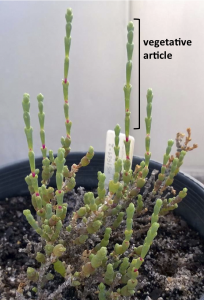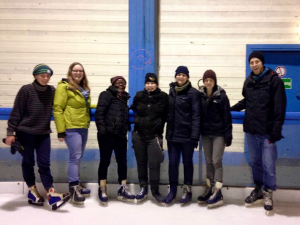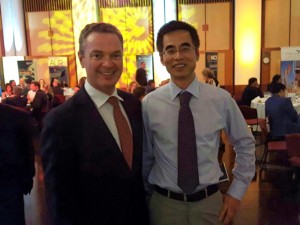- About
- Members
- Join
- Member log in
- Membership Renewal
- Member directory
- Life Members
- ASPS Life Member Professor Graham Farquhar
- ASPS Life Member Associate Professor Hendrik (Hank) Greenway
- ASPS Life Member Dr Marshall (Hal) D Hatch
- ASPS Life Member Dr Paul E Kriedmann
- ASPS Life Member Dr Mervyn Ludlow
- ASPS Life Member Emeritus Professor Rana Munns
- ASPS Life Member Conjoint Professor Christina E Offler
- ASPS Life Member Professor (Charles) Barry Osmond
- ASPS Life Member Emeritus Professor John W Patrick
- ASPS Life Member Dr Joe Wiskich
- Corresponding Members
- Elected Fellows
- Events
- Awards & Funding
- Employment
- Publications
- Research
- Teaching
- Menu
C4 photosynthesis in a genus of succulents native to Australian salt lakes
11 May 2016
R.N. Robertson Travelling Fellowship Report by Nicole Dakin
(School of Chemistry and Biochemistry, University of Western Australia)
At first, you wouldn’t think there was much connection between a snow-covered forest in Germany, and a sunny salt lake in Australia. My PhD project investigates C4 photosynthesis in Tecticornia, a genus of succulents native to Australian salt lakes (Photo 1). Through the support of the R.N. Robertson Travelling Fellowship, I travelled to Mainz, Germany to complete part of my research, supervised by Dr. Gudrun Kadereit at the Johannes Gutenberg Universität Mainz.
 Photo 1: Tecticornia indica subsp. bidens, a C4 species. An example of a vegetative article is shown. Photo 1: Tecticornia indica subsp. bidens, a C4 species. An example of a vegetative article is shown. |
Tecticornia is a genus in the family Chenopodiaceae. These plants are halophytes, and the majority of species are endemic to Western Australia. Tecticornia species have highly reduced features, an adaptation to the harsh conditions in which they live. Their stems and leaves are fused into cylindrical structures called vegetative articles (see photograph included). Their flowers are embedded in these vegetative articles, with only the stamens visible. This leaves few morphological features to identify species, and discerning between species can be challenging. In addition, hybridisation and variation in ploidy levels are common. Previous phylogenetic studies have found low genetic diversity between species. The phylogeny of the genus remains unresolved, and the relationships among the species are not clear.
Tecticornia currently includes two C4 species and 39 C3 species. These C4 species among a large number of C3 species make it an interesting genus for studying the steps in the evolution of C4 photosynthesis. The evolution of C4 photosynthesis involves changes in anatomy, protein localisation, and expression, and my PhD project sets out to study these steps in Tecticornia. However, before these studies can be completed, the C3 species most closely related to the C4 species must be identified.
My aim during my time in Germany was to use the external transcribed spacer (ETS) region as a nuclear marker to construct a phylogeny of the genus. Previous studies have used chloroplast markers and the internal transcribed spacer region (ITS) marker, and information from the ETS marker would further contribute to resolving the phylogeny of the genus.
A question I was asked a lot was “Why would a Western Australian student, studying a Western Australian genus, come to Germany?” Members of the Kadereit lab (Photo 2) are experts in the family Chenopodiaceae, conducting studies into the phylogenetics, biogeography, anatomy, and taxonomy of a wide range of species in this family. Members of the lab have completed studies into particular genera, and broader-scale studies of the family, and have integrated these studies with their extensive knowledge of the biology of the plants.

Photo 2: Ice-skating with Gudrun, and other students from the Kadereit lab. |
I learnt how to extract total DNA from dried herbarium tissue, amplify the ETS fragment, and determine sequences from over 70 samples. These sequences were aligned, and I was taught how to use various programs to construct phylogenetic trees. The phylogenetic reconstruction was a lot more challenging than first expected. The amplification of paralogous sequences caused unusual branch lengths in the first trees constructed, and conflict between trees using different markers. Some samples had to be repeated with different primer pairs to obtain the orthologous sequences. The amplification of paralogues is an unusual problem, and is thought to be due to recent hybridisation between species.
The ETS phylogeny, combined with the ITS marker, had greater resolution compared to previous studies. A number of well-supported clades could be seen, dividing the genus into groups. The position of the C4 species indicates they form a separate clade. The phylogeny revealed that the Tecticornia are a very young C4 lineage. A rapid diversification and hybridisation, as seen from the paralogous sequences, make it a challenging genus to fully resolve. The information from this phylogeny will help choose further markers to fully resolve the species relationships in the genus.

Photo 3. A snow-covered scene in the Lennebergwald forest, Mainz. |
I was also able to connect my findings with other studies. For example I was able to fit my phylogeny into a larger ETS phylogeny of a subfamily of Chenopodiaceae. My study, as well as increasing knowledge of Tecticornia, will also be valuable in resolving relationships across the whole family. I also picked up skills in hydrating dry herbarium material, and sectioning it to look at the anatomy; a difficult task for succulent tissue.
I used my free time to explore the city of Mainz. There was a beautiful forest close to where I was staying (Photo 3), and many museums and historical sites (Photo 4). Mainz, located on the Rhine River, has a rich history, and is the birthplace of Johannes Gutenberg, inventor of the first printing press.
 Photo 4. Exploring the markets in the centre of Mainz. Photo 4. Exploring the markets in the centre of Mainz. |
Thank you to Gudrun Kadereit for her mentorship and teaching, and thank you to my other supervisors: Martha Ludwig from the University of Western Australia, and Kelly Shepherd, and Terry MacFarlane from the Western Australian Herbarium. Thank you to Silvia Wienken and Max Lauterbach, and the members of the Kadereit lab who gave me advice and help during my stay: Michael Pirie, Uschi Martine, Katherina Bohley, and Denise Schmidt. And thank you to the ASPS for the honour of receiving the R.N. Robertson Travelling Fellowship, and allowing me to undertake this research.
Email: nicole.dakin@research.uwa.edu.au
ComBio2016 update, Science and Technology Australia newsletter and Global Plant Council E-Bulletin April 2016
09 May 2016
Your membership is paid to [wpmlfield name=”paidtodate”] (Year, Month, Day)
-
ComBio2016 – updated , timetable and Power Point
-
Ulrike Mathesius represents ASPS on the Science and Technology Australia board and would like to forward a special newsletter for the federal budget that might be interesting for ASPS members. Available here.
-
Global Plant Council E-Bulletin April 2016
|
|||||||||||||||||||||||||||||||||||||
|
|||||||||||||||||||||||||||||||||||||
|
|||||||||||||||||||||||||||||||||||||
|
Characterisation of the low affinity ammonium transporters in maize
01 May 2016
by Wending Li
ASPS Travel Awards Recipients for ComBio2015
PhD candidate, Centre for Carbon, Water and Food, Faculty of Agriculture and Environment, The University of Sydney
My research focuses on understanding ammonium transport in maize. In agricultural plant production, nitrogen fertilisers are used widely where ~1011 kg of nitrogen fertilizers are used annualy (Glass, 2003). The cultivation of cereals (wheat, maize, barley, rice) requires a significant amount of nitrogen fertiliser. Unfortunately, cereal N fertiliser use is poor, where only 30-50% of the total N applied is actually used for the production of the final grain yield (Raun and Johnson, 1999; Tilman et al., 2002). Low nitrogen use efficiencies can result in the loss of nitrogen into the environment, which causes water and soil pollution as well as greenhouse gas production (Masclaux-Daubresse et al., 2010). In addition, the waste of nitrogen fertilizers also gives rise to financial losses to the farmers, a significant cost in the production cycle. Therefore, improving plant nitrogen use efficiency (NUE) is an important strategy to overcome many of these constraints. One direction in enhancing NUE in plants is to increase the efficiency of root N transport processes. This includes, the proteins involved in the uptake of nitrogen from the soil as well as the internal storage and redistribution of nitrogen required to support growth and final seed yield and quality (Garnett et al., 2009).
Ammonium is a major form of nitrogen absorbed by plants and can be redistributed through high and low affinity pathways. The physiological and molecular activities of high-affinity ammonium transporters have been examined in numerous plant species, which belong to the AMT/MEP/Rhesus superfamily. Conversely, molecular information about low-affinity ammonium transport systems remains limited. Recently, our lab has discovered a new family of low affinity ammonium transport proteins called AMF1 (ammonium facilitator 1) (Chiasson et al., 2014). Through sequence homology, we found two AMF1 homologs in maize, which are ZmAMF1;1 and ZmAMF1;2. I have been investigating the function of these two genes in maize as well as using heterologous expression systems (yeast and Xenopus laevis oocytes) to define their functional relevance in nitrogen transport and overall plant growth. In maize, I’ve observed ZmAMF1 is induced by nitrogen starvation in roots, while both ZmAMF1 and ZmAMF2 are preferentially expressed in the shoots. The cellular location of both genes is currently being identified using a native promoter::GUS fusion construct transformed into the dwarf maize inbred line Gaspe. I have undertaken a reverse genetics approach in maize using a collection of Mu transposon insertion lines within exon and promoter loci of either ZmAMF1 or ZmAMF2 (provided by B. Meeley, DuPont Pioneer). We have progressed the transposon lines through a series of backcrosses to B73 and Gaspe using a diagnostic PCR screening assay. Mutant plants containing perturbations in ammonium transport in maize are undergoing characterisation. This project will contribute to a better understanding of the role AMF1 proteins in plant N transport and metabolism, including their role as low-affinity ammonium transporters. Our research will improve our understanding of nitrogen uptake and redistribution in plants, whiles also establishing new strategies to improve nitrogen use efficiency, plant growth and development.
Reference:
Chiasson DM, Loughlin PC, Mazurkiewicz D, Mohammadidehcheshmeh M, Fedorova EE, Okamoto M, McLean E, Glass AD, Smith SE, Bisseling T (2014) Soybean SAT1 (Symbiotic Ammonium Transporter 1) encodes a bHLH transcription factor involved in nodule growth and NH4+ transport. Proceedings of the National Academy of Sciences 111: 4814-4819
Garnett T, Conn V, Kaiser BN (2009) Root based approaches to improving nitrogen use efficiency in plants. Plant, cell & environment 32: 1272-1283
Glass AD (2003) Nitrogen use efficiency of crop plants: physiological constraints upon nitrogen absorption. Critical Reviews in Plant Sciences 22: 453-470
Masclaux-Daubresse C, Daniel-Vedele F, Dechorgnat J, Chardon F, Gaufichon L, Suzuki A (2010) Nitrogen uptake, assimilation and remobilization in plants: challenges for sustainable and productive agriculture. Annals of Botany 105: 1141-1157
Raun WR, Johnson GV (1999) Improving nitrogen use efficiency for cereal production. Agronomy Journal 91: 357-363
Tilman D, Cassman KG, Matson PA, Naylor R, Polasky S (2002) Agricultural sustainability and intensive production practices. Nature 418: 671-677
THINKING BIG – A Report from an ASPS Travel Award Recipient
27 April 2016
By Dr. Zhengyu (Allen) Wen
Postdoctoral Research Fellow, Centre for Carbon, Water and Food, Faculty of Agriculture and Environment, School of Life and Environmental Sciences, The University of Sydney
ComBio 2015 was well above my expectation. As a plant physiologist interesting in ion transporter research, I had previosuly attended conferences relevant to my area of expertise and found myself comfortable enjoying the science. ComBio is a combined conference covering multiple fields of science and I had some minor trouble submitting my abstract to the relevant plenary that best aligned with my research topic, which did make me wonder about the scope of science that was to follow. But as the conference began, I realized that the 2015 ComBio was going to provide a big and pleasant experience. Professor Martin Caffrey’s lecture discussed new insights into protein structural biology and how it can effect protein function, which was very interesting from a structural biology perspective. I learn’t that there were new ways to crystallise a protein. Given the current difficulties in crystallizing ion transporters, this new method could potentially be used to solve the structure of ion transporters relevant to my research program. I also learn’t a lot from the epigenetics talks, which could pave new ways for crop biofortification and modification. Overall, ComBio2015 truly broadened my view in science, pushing me to think big.
Plant Development Discipline Report
27 April 2016
by Dr. Matthew Tucker
ARC Future Fellow at The University of Adelaide
It’s been a busy start to the year in terms of conferences and workshops relevant to plant research. The bi-annual Plant Reproduction meeting was held from the 18th to 23rd of March at the University of Arizona in Tucson. The conference brings together experts from diverse fields stretching all the way from meristem development through to sporogenesis, pollen tube attraction, fertilisation, embryogenesis, endosperm development and fruit growth. The ultimate aim of the conference is to describe fundamental research from model species, such as the discovery of genes, mechanisms and biochemical pathways, which might be used to address current and future challenges in crop reproduction and yield. The conference was well attended with approximately 220 attendees, and the quality of data presented was amazing. Australian attendees included researchers from CSIRO Agriculture, The University of Adelaide and the ACPFG. The highlights were talks from Minako Ueda from the University of Nagoya, who showed stunning videos of fluorescently-tagged Arabidopsis egg cells developing into zygotes, Noni Franklin-Tong from the University of Birmingham, who described her work on transferring the self-incompatibility system from poppy into Arabidopsis, and Li Yuan from UC Davis who won an award for his talk on a histidine kinases that controls central cell development in the Arabidopsis female gametophyte. The discovery of genes controlling or inducing apomixis in maize, Taraxacum and Pennisetum was also a major breakthrough. It was clear from the talks that CRISPR/Cas9 and ChipSeq are now standard techniques in the field, while the capacity to isolate, profile and study previously inaccessible cell types through fluorescence assisted cell sorting (FACS) and microdissection is also rapidly progressing. The next plant Reproduction meeting will be held in Japan in 2018, and I would strongly recommend attending what always proves to be a collaborative, interactive and socially enjoyable meeting.
Photos of the Tucson desert moon, the famed Dr Minako Ueda with the author, the packed conference and Tetsuya Higashiyama introducing the next Plant Reproduction meeting.
Another excellent CSIRO workshop was recently held from the 19th-21st April in Kiama on the NSW south coast. The workshop, also sponsored by the ASPS, brought together Australian and International researchers from the field of Crop Developmental Genetics to discuss old and new strategies for the improvement of crop yield. Cereal crops such as wheat, barley and sorghum were discussed in addition to research on lupins, canola, tomato and legumes. Talks from international speakers including Jorge Dubcovsky from UC Davis, Junko Kyozuka from Tohoku University, Thorsten Schnurrbusch from IPK Gatersleben and Yuval Eshed from the Weizmann Institute were highlights, while students from CSIRO, ANU, the Universities of Adelaide, Queensland and Monash confirmed that the future of plant developmental genetics in Australia is in good hands. The intention was to use this workshop as a springboard for further collaborative research and meetings; plant developmental genetics is a relatively small field that provides so much promise for translating fundamental discoveries directly into breeding outcomes. As part of this I plan to update the ASPS Plant Development page to include information about the field and the research being undertaken in Australia, hopefully this will act as a useful resource for both students and researchers.
ComBio2016 – Online registration and abstract submission is now open AND update of student awards and travel grants
19 April 2016
Your membership is paid to [wpmlfield name=”paidtodate”] (year, month, day).
ComBio2016: 3 – 7 October 2016
Brisbane Convention & Exhibition Centre
Abstract and Early Registration Deadline, Monday, 27 June 2016
Dear Past and Present Members
ComBio2016 incorporates the annual meetings of the Australian Society for Biochemistry and Molecular Biology, the Australian Society of Plant Scientists and the Australia and New Zealand Society for Cell and Developmental Biology.
We are pleased to advise that the ComBio2016 online registration and abstract submission pages can now be accessed at:
and
http://www.asbmb.org.au/combio2016/abstracts.html respectively.
The Provisional Program Timetable can be accessed from: http://www.asbmb.org.au/combio2016/timetable.html
The Provisional Symposium Schedule (including titles of sessions and chairs)will be available from http://www.asbmb.org.au/combio2016/symposia.html at the end of April.
Plenary speaker details including photographs and biographies can be downloaded from: http://www.asbmb.org.au/combio2016/plenary.html
The ASBMB, ASPS and ANZSCDB offer either student bursaries or travel grants, and details will be available from: http://www.asbmb.org.au/combio2016/student.html at the end of April.
The conference secretariat has held blocks of reasonably priced hotel and apartment accommodation in walking distance to the Brisbane Convention Centre. Per night costings start from $129/night for hotel single/twin/double accommodation and from $165/night for one bedroom apartment accommodation which is great for sharing. Apartments include separate living room and kitchen. Bookings must be made directly with the conference secretariat on the online registration form. No deposit is required.
Further information: Sally Jay: combio@asbmb.org.au
ComBio2016 Awards
19 April 2016
- ASPS will make up to 5 awards for research presented as a poster by students at ComBio2016, depending on the number of posters. Each award will consist of recognition at the end of the conference and a prize of $200.
- Student members of ASPS may also apply in advance for a travel award to attend ComBio2016, if presenting their research as either a poster or talk. Applications are due June 10th to the Hon. Treasurer of ASPS: brent.kaiser@sydney.edu.au
- The Peter Goldacre Award is the ASPS award for excellence in early career research. The award ($2000, a medal and invited lecture at ComBio) is sponsored by Functional Plant Biology.
- Award for best paper (2016) by an early career plant scientist published in Functional Plant Biology (certificate, $250 book voucher from CSIRO publishing). Selected from papers published in 2015 in Functional Plant Biology and nominated during the submission process.
- The ASPS Teaching Award may also be presented (certificate and prize) at ComBio2016.
- The R.N. Robertson Lecture will take place at ComBio2016. (The R.N. Robertson Lecture alternates each year with the J.G. Wood Memorial Lecture).
- For more information, http://www.asps.org.au/awards
Plasmodesmata in rice and Setaria: A comparison of symplastic transport mechanisms in C3 and C4 plants
18 April 2016
Article by Florence Danila: Recipient of the ComBio 2015 ASPS Student Poster Prize
A large majority of the human population depends on rice (Oryza sativa) for survival. Rice production needs to increase by 50% to support a higher demand for food forecasted over the next 35 years due to an increasing human population. Traditional breeding can only increase rice yield by 1% per annum. Switching the less efficient C3 photosynthetic system of rice to use a more efficient C4 photosynthesis, would theoretically increase productivity by 50%. The aim of the C4 Rice Consortium is to add features of C4 photosynthesis to the C3 plant, rice. Therefore, it is essential to know whether rice can support the expected increase in metabolite flux between the leaf mesophyll (M) and bundle sheath (BS) cells after all the C4 biochemistry has been installed. The main pathway for metabolite flux is symplastic, i.e. via the plasmodesmata (PD) connecting M and BS cells. Comparison of the symplastic transport mechanisms between the C3 monocot crop, rice, and the C4 plant, Setaria viridis was done by looking at the PD density and pit field distribution between the M and BS cells. Electron microscopy and 3D immunolocalisation showed that Setaria (C4) has higher PD density and higher pit field area coverage on M/BS cell interface than rice (C3). Establishing the numerical difference in terms of PD connections between C3 and C4 plants is not only relevant for the C4 Rice Project but also in plant transport and modelling studies.
Acknowledgements:
ARC Centre of Excellence for Translational Photosynthesis (Research School of Biology, Australian National University, Canberra, Australia). International Rice Research Institute (Laguna, Philippines). CSIRO Agriculture (Canberra, Australia).
KILLING FUNGAL PATHOGENS – DETERMINING THE MODE OF ACTION OF AN ANTIFUNGAL DEFENSIN
06 April 2016
Article by JENNIFER PAYNE: Recipient of the ComBio 2015 ASPS Student Poster Prize
Plants can’t run and and hide from their enemies. They are rooted to the spot and consequently have developed sophisticated defence mechanisms to shield them from potential invaders. Unlike animals they don’t have an adaptive immune system and rely instead on physical barriers such as waxy cuticles, secondary metabolites and innate immunity proteins for protection against potential microbial pathogens. Plant defensins, are a crucial part of this innate immune system. They are small, stable, cysteine-rich proteins that are produced by all plant taxa and most plant tissues. NaD1 a plant defensin from the ornamental tobacco Nicotiana alata, has potent antifungal activity against a range of serious plant pathogens that can devastate crop yields and we have been exploring its potential application in crop protection. NaD1’s antifungal mechanism is complex involving multiple steps, beginning with specific interaction with the fungal cell wall, followed by disruption of the plasma membrane and entry into the cytoplasm where it initiates cell death. Unlike most antifungal molecules, NaD1 requires an intact cell wall for its antifungal activity. The fungal cell wall is unique to fungi, creating an ideal selective target for new generation fungicides. It is composed of three layers; an outer glycoprotein layer, a β-1,3-glucan layer and a chitin layer immediately adjacent to the plasma membrane. Direct binding assays and chemical and genetic alteration of the thickness of the cell wall layers revealed that NaD1 binds with a higher affinity to chitin than β-1,3-glucan. This led to the hypothesis that NaD1 might be directed through the wall and onto the plasma membrane by an affinity gradient, a novel mechanism for passage through the cell wall. Once through the wall, NaD1 must pass through the plasma membrane to enter the cytoplasm and kill the fungal cell. The interaction between NaD1 and the membrane was studied using liposomes and bilayers of different lipid composition together with dual polarisation interferometry. This revealed that; NaD1 only interacts with membranes containing phosphatidylinositol 4, 5-bisphosphate, the membrane becomes disordered upon NaD1 binding, and NaD1 does not dissociate from the membrane after binding (Payne et al 2016). These data supported the work of Poon and colleagues (2014) who reported that NaD1 and phosphatidylinositol 4, 5-bisphosphate form an elegant arc shaped oligomer and highlighted a new mechanism for membrane disruption by an antimicrobial peptide.
References:
Payne, J. A., Bleackley, M. R., Lee, T. H., Shafee, T. M., Poon, I. K., Hulett, M. D., . . . Anderson, M. A. (2016). The plant defensin NaD1 introduces membrane disorder through a specific interaction with the lipid, phosphatidylinositol 4,5 bisphosphate. Biochim Biophys Acta, 1858(6), 1099-1109. doi:10.1016/j.bbamem.2016.02.016
Poon, I. K., Baxter, A. A., Lay, F. T., Mills, G. D., Adda, C. G., Payne, J. A., … Hulett, M. D. (2014). Phosphoinositide-mediated oligomerization of a defensin induces cell lysis. eLife, 3, e01808. http://doi.org/10.7554/eLife.01808
For more information email: ja2payne@students.latrobe.edu.au (La Trobe University, Melbourne Victoria Australia)
Science Meets Parliament 2016
06 April 2016
| By Professor Yong-Ling Ruan at The University of Newcastle |
On behalf of Australian Society of Plant Scientists, I joined Science Meets Parliament (SMP) on the 1st and 2nd of March, 2016 in Canberra. The SMP aims to provide scientists unique opportunities to build mutual understanding and connections between scientists and parliamentarians and to better understand the policy making process connecting science and innovation that underpins Australia’s economic, social and environmental wellbeing.
|
Professor Yong-Ling Ruan, ASPS representative, and Hon Christopher Pyne, MP, and Minister for Industry, Innovation and Science at the Science Meets Parliament 2016 at the Great Hall of the Australian Parliament House in Canberra on the 1 March 2016. |
Day 1 of the SMP started with an opening address given by Professor Brian Schmidt (AC, Nobel Laureate and Vice Chancellor of ANU) at the Hotel Realm. Prof Schmidt analysed a broad aspects of Australian Science and offered a few ‘tips’ on how to talk to politicians. This was followed by a vivid discussion and debate on ‘How to turn your science into news’, presented by Kylie Walker (Australian Academy of Science), Paul Bongiorno (Network Ten) and Alison Carabine (ABC radio). The meeting continued with an ‘Interactive session’ on rehearsing for parliamentary meetings and concluded with a Gala dinner at the Great Hall in Parliament House where key note speakers, the Hon Christopher Pyne MP, (Minister for Industry, Innovation and Science) and the Hon Bill Shorten MP (Leader of the Opposition) addressed the audience outlining their policies and visions for the future of Australian science.
Day 2 featured face-to-face group meetings in Parliament House with Ministers, Parliamentary Members and Senators. Their were concurrent sessions on Science and Politics delivered by past and present Federal Chief Scientists, Professors Ian Chubb and Alan Finkel, respectively, as well as Aidan Byrne (ARC CEO Professor) and Senator Kim Carr (Shadow Minister for Higher Education, Research, Innovation and Industry).
The two-day event proved to be a very rewarding experience. It helped to better understand and appreciate the process of formulating science-related policies and decisions developed at the government level. It provided a unique opportunity to network with politicians, journalists and fellow scientists while advocating plant science to the broader community. To the latter, I attached here a photo with the Science Minister Chris Pyne at the Gala diner following his keynote speech and our informal discussion.
Email: yong-ling.ruan@newcastle.edu.au
Recent Posts
Tags
Archives
- June 2025
- May 2025
- April 2025
- March 2025
- February 2025
- January 2025
- December 2024
- November 2024
- October 2024
- September 2024
- August 2024
- July 2024
- June 2024
- May 2024
- April 2024
- February 2024
- January 2024
- November 2023
- October 2023
- September 2023
- August 2023
- July 2023
- June 2023
- May 2023
- April 2023
- March 2023
- February 2023
- December 2022
- November 2022
- October 2022
- September 2022
- August 2022
- July 2022
- June 2022
- May 2022
- April 2022
- March 2022
- February 2022
- January 2022
- December 2021
- November 2021
- October 2021
- September 2021
- August 2021
- July 2021
- June 2021
- April 2021
- March 2021
- February 2021
- January 2021
- December 2020
- November 2020
- October 2020
- September 2020
- August 2020
- July 2020
- June 2020
- May 2020
- April 2020
- March 2020
- February 2020
- January 2020
- December 2019
- November 2019
- October 2019
- September 2019
- August 2019
- July 2019
- June 2019
- May 2019
- April 2019
- March 2019
- February 2019
- January 2019
- December 2018
- November 2018
- October 2018
- September 2018
- August 2018
- July 2018
- June 2018
- May 2018
- April 2018
- March 2018
- February 2018
- January 2018
- December 2017
- November 2017
- October 2017
- September 2017
- August 2017
- July 2017
- June 2017
- May 2017
- April 2017
- March 2017
- February 2017
- January 2017
- December 2016
- November 2016
- October 2016
- September 2016
- August 2016
- July 2016
- June 2016
- May 2016
- April 2016
- March 2016
- February 2016
- January 2016
- December 2015
- November 2015
- October 2015
- September 2015
- August 2015
- July 2015
- June 2015
- May 2015
- April 2015
- March 2015
- February 2015
- January 2015
- December 2014
- November 2014
- October 2014
- September 2014
- August 2014
- July 2014
- June 2014
Copyright 2017 Australian Society of Plant Scientists Disclaimer & Privacy
Website by Michael Major Media








